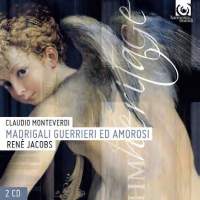Texte paru dans: / Appeared in: |
|
|
Outil de traduction (Très approximatif) |
|
|
|
|
|
Reviewer: J.
F. Weber I had to begin this listening experience by verifying that the entire Book 8 is contained here in a version that is some 36 minutes shorter than the same music that the Consort of Musické put on three discs (14:4 and 15:2). The latter set interpolated a ten-minute ballet into Volgendo il ciel, but added instrumental interludes in other pieces account for most of the difference. Emanuela Marcante apparently put the whole book on two CDs about three years ago, but the discs have not shown up here. Earlier, the first complete sets oí Book 8 came from Edwin Loehrer (four LPs, not issued here) and Raymond Leppard (4:5 for a reissue on three LPs; as a set of two CDs it was not issued here), and recently we had two discs of a planned complete set by Rinaldo Alessandrini (21:2, 22:2). But there have been endless duplications of the most celebrated pieces in the set. Only Monteverdi's first six books were madrigals in the strict sense, all for five voices, and their publication between 1587 and 1614, soon after their composition, unfolded the composer's development of madrigal writing. The seventh book of 1619 was titled Concerto, for it contained a variety of vocal works, none of them for five voices. Carrying forward the latest developments of the two preceding books, the madrigale concertato focused on the virtuosity of the individual voices, and the book contained “other kinds of songs“ as well. (We just heard a marvelous recording of this book in 26:4.)
Book 8, on the other hand, was
only printed in 1638, and it drew on two decades of composition, in addition
to a few earlier unpublished works. The span of time is suggested by the two
balli, one as late as 1637 (Volgendo il ciel), the other as old as 1608 (Ballo
delle ingrate), that are placed at the end of each part. The book is divided
into two parts, madrigals of war and of love. The former begins with “Let
others sing of love,“ while the latter begins “Let others sing of war“—one
the mirror image structurally of the other. The centerpiece of each part is
in genere rappresentativo (that is, calling for some dramatic staging). Il
combattimento di Tancredi e di Clorinda from Tasso's epic poem, Gerusalemme
liberata, is in the first part, of course, and Lamento della ninfa is the
staged madrigal of love. From 1613 on, Monteverdi had been devoting most of
his attention to the basilica of St. Mark's, and after the plague subsided
in 1631 he reduced his activity considerably. This book of 1638 and the
Selva morale e spirituale of 1640 (25:3) were the retired master's effort to
preserve his mature work for posterity. He died in 1643; another collection
of sacred music and a Ninth Book of Madrigals were published about eight
years later.
For this extraordinary
presentation of the Eighth Book, René Jacobs has assembled an ensemble of
mostly unfamiliar singers who are more than equal to some very celebrated
interpreters of this music. Of the 12 singers, only Maria Cristina Kiehr and
Bernarda Fink participated in any of the Monteverdi operas that Jacobs
directed a few years ago, although three other members sang in his more
recent Vespro della Beata Virgine. His achievement is evident in //
combattimento di Tancredi e di Clorinda, one of the greatest works in this
marvelous book. Salomé Haller sings Clorinda, Kobie van Rensburg is Tancredi,
and baritone Victor Torres is the narrator. Although the Consort of Musické
included Emma Kirkby on their disc, these singers are every bit their equal,
and the tenor narrator and slower progress (those interludes) on that set
are less attractive than this stunning performance. Concerto Italiano used
unfamiliar Italian singers, including a baritone narrator, for one of the
finest versions of the piece. Between the English Consort of Musické and the Concerto Italiano (even if an incomplete set), this multinational ensemble is what Robert Browning would have called a tertium quid, a “third something“ that offers a fascinating alternative to a pair of choices. There is not a weak singer in the group, and repeated comparisons keep affirming that this new version is the finest set of Book 8 ever. Certainly, there are equally fine versions of many pieces, but no finer set than this. For what it's worth, the book is laid out in published order, not setting the largest works apart. The packaging, placing a digipack and the 92-page booklet inside a box, is elegant. There is only one track for each number except the longest (Ballo delle ingrate). Anyone who is looking for Monteverdi's Book 8 need go no farther than this.
| |
|
Sélectionnez votre pays et votre devise en
accédant au site |
|
|
|
|
|
|
|
|
Cliquez l'un ou l'autre
bouton pour découvrir bien d'autres critiques de CD |
|



